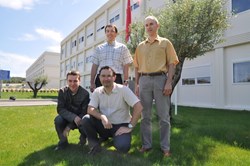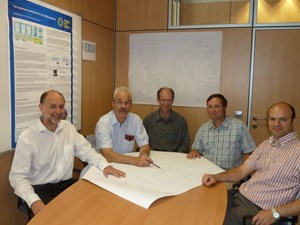
Procurement of the ITER cryoplant will be shared by Europe (nitrogen plant, in blue), ITER Organization (helium plant, in yellow) and India (cryolines and cryodistribution components, in green).
In the larger-than-life ITER Tokamak, everything will be big ... from the toroidal field coils each weighing as much as a loaded Boeing 747 airplane ... to the volume of the ITER plasma, nearly ten times that of the largest currently operating tokamak.
It comes as no surprise, then, that the ITER cryoplant will also be impressive in size. With an installed cooling power of 65 kW at 4.5 K and up to 1300 kW at 80 K, it will be the largest concentrated cryogenic system in the world (see related article in
Newsline 168).
Cryogenic technology will be extensively used at ITER to create and maintain low-temperature conditions for magnets, thermal shields, cryopumps and some diagnostics systems. The
ITER cryoplant—composed of helium and nitrogen refrigerators, an 80 K helium loop and all the necessary auxiliary systems for efficient and uninterruped operation—will produce the required cooling power to be distributed through a complex system of cryolines and cold boxes that make up the cryodistribution system.
This week, another step towards the procurement of the ITER cryogenic system was taken with the signature of the Procurement Arrangement for the liquid nitrogen (LN2) plant and auxiliary systems with the European Domestic Agency.

This week's signature was the result of international teamwork. Pictured: (top) Emmanuel Monneret (TRO) and Denis Henry, (bottom) Guillaume Vincent, Nicolas Navion-Maillot for the ITER Organization ...
The LN2 plant will provide liquid nitrogen cooling for the liquid helium plant and the 80 K helium loop, as well as storage for the LN2 inventory. The plant is made up of two nitrogen refrigerators, two 80 K helium loop refrigerators, helium and nitrogen storage, helium recovering and purification, and heaters.
"The ITER cryogenics system is a closed loop system," explains Emmanuel Monneret, Technical Responsible Officer for the Procurement Arrangement and member of ITER's cryogenics team. "We need the capacity to store the entire inventory of gases during maintenance periods, when the ITER magnets are returned to room temperature. The inventory (25 tonnes of helium and 160 tonnes of liquid nitrogen) is recovered and stored in warm (300 K) and cold (4 K and 80 K) tanks until needed again for operation." (The tanks are shown in blue in the above diagram.)
In addition, two giant 80 K quench tanks are reserved for the recovery of helium in case of a magnet quench—a situation where superconductivity is lost due to a local temperature rise in the magnets.
The European Domestic Agency (EU-DA) is responsible for the detailled design, manufacturing, installation and testing of the LN2 plant and auxiliary systems. "Two aspects of this procurement are 'out of the ordinary,'" says Emmanuel. "First, the storage designed for quench recovery will be the largest of its kind. And second, the plant will use a helium gas compression technique—centrifugal compression—that has never been used before on this scale. Standard helium oil screwed compressors can't be used in this case because of the compression ratio and flow volume required by the ITER machine."

... and Alain Teissier (TRO); Rainer Lässer, Jarl Buskop, Grigory Kouzmenko and Marc Simon for the European Domestic Agency.
"This has certainly been a challenging Procurement Arrangement to prepare," says Plant Engineering Division Head Luigi Serio. "The team worked very hard to establish the conceptual design and finalize the requirements for an efficient and reliable plant. We're satisfied with the result and with the collaborative spirit established with our colleagues at EU-DA, to whom we now hand over
procurement responsibility."
"Unfortunately ... there is no time to celebrate!" he adds. "We have to issue the call for tender for the direct procurement of the Helium refrigerators before August."
Approximately three years will be necessary for the design and manufacturing of the LN2 plant and auxiliary systems. The first component deliveries are expected at the end of 2014 for installation and testing activities to begin.




